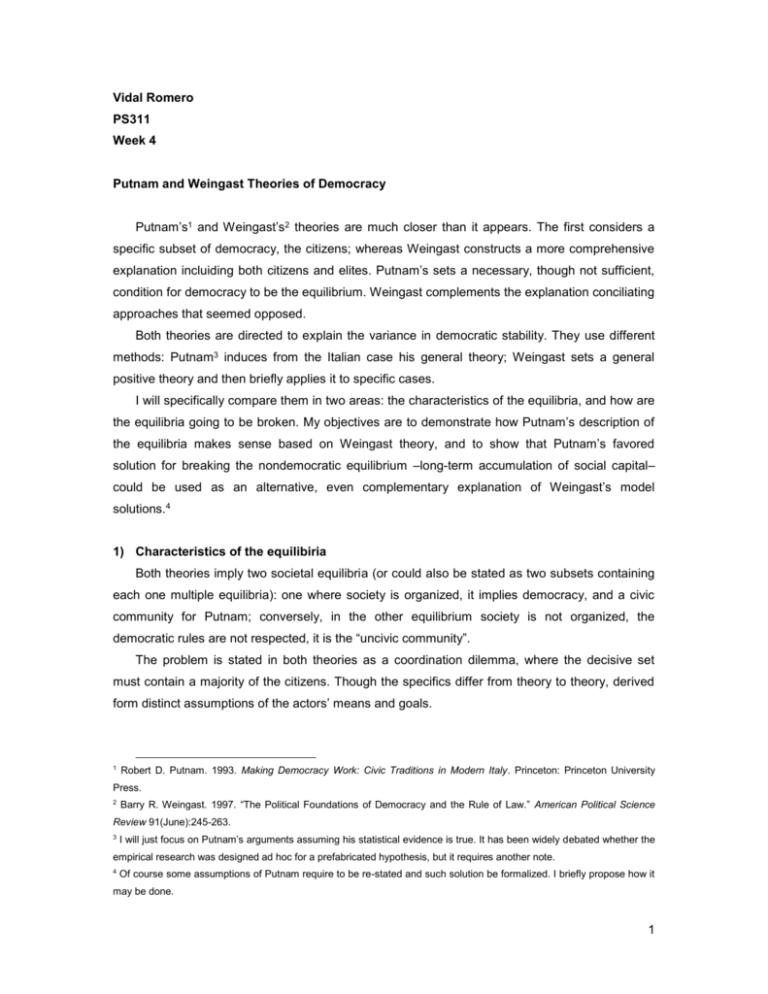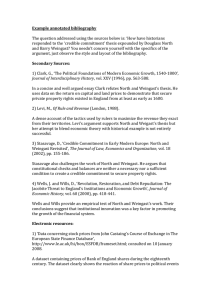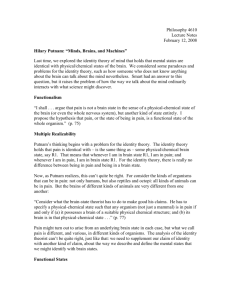Vidal Romero - Stanford University
advertisement

Vidal Romero PS311 Week 4 Putnam and Weingast Theories of Democracy Putnam’s1 and Weingast’s2 theories are much closer than it appears. The first considers a specific subset of democracy, the citizens; whereas Weingast constructs a more comprehensive explanation incluiding both citizens and elites. Putnam’s sets a necessary, though not sufficient, condition for democracy to be the equilibrium. Weingast complements the explanation conciliating approaches that seemed opposed. Both theories are directed to explain the variance in democratic stability. They use different methods: Putnam3 induces from the Italian case his general theory; Weingast sets a general positive theory and then briefly applies it to specific cases. I will specifically compare them in two areas: the characteristics of the equilibria, and how are the equilibria going to be broken. My objectives are to demonstrate how Putnam’s description of the equilibria makes sense based on Weingast theory, and to show that Putnam’s favored solution for breaking the nondemocratic equilibrium –long-term accumulation of social capital– could be used as an alternative, even complementary explanation of Weingast’s model solutions.4 1) Characteristics of the equilibiria Both theories imply two societal equilibria (or could also be stated as two subsets containing each one multiple equilibria): one where society is organized, it implies democracy, and a civic community for Putnam; conversely, in the other equilibrium society is not organized, the democratic rules are not respected, it is the “uncivic community”. The problem is stated in both theories as a coordination dilemma, where the decisive set must contain a majority of the citizens. Though the specifics differ from theory to theory, derived form distinct assumptions of the actors’ means and goals. 1 Robert D. Putnam. 1993. Making Democracy Work: Civic Traditions in Modern Italy. Princeton: Princeton University Press. 2 Barry R. Weingast. 1997. “The Political Foundations of Democracy and the Rule of Law.” American Political Science Review 91(June):245-263. 3 I will just focus on Putnam’s arguments assuming his statistical evidence is true. It has been widely debated whether the empirical research was designed ad hoc for a prefabricated hypothesis, but it requires another note. 4 Of course some assumptions of Putnam require to be re-stated and such solution be formalized. I briefly propose how it may be done. 1 Putnam argues that democracy to be stable requires “civic” citizens organized to achieve a collective good; whereas Weingast assumes all actors to be self-interested, and democratic stability to be the result of citizen’s coordination over the specific limits of the state that they are willing to defend, it is certainly not a question of virtue. The logic of democratic stability in Putnam assumes that the equilibrium in democracy is going to be self-enforcing when citizen’s values and behavior have generated a sufficient quantity of “social capital” working as a behavioral constraint. It implies that citizens are coordinated to trigger the sovereign actions, as required by Weingast. Though a difference is to be noted, Weingast argues that citizen attitudes, values, and behavior are central to democratic stability, but are not its cause –as argued by Putnam-, it is a reflection of the equilibrium. Putnam’s provides an accurate description of the equilibrium based on the variance of government performance, which is at the hearth of his theory. His argument assumes, in the democratic equilibrium, a government interested in the society’s well being. Weingast argument is quite different, the government is also self-interested, and seeks to extract a maximum of rents assuming the constraints set by the citizen’s coordination, it is not his main goal to benefit the citizens, unless it is in his own interest. At the end of the path, both agree that the democratic equilibrium provides a Pareto efficient solution for society. Weingast’s plus are elites. Elites in power (labeled as the sovereign) complicates the citizen’s efforts to coordinate, to create a “civic community”. The sovereign may transgress selectively some groups of citizens and not others, creating decisive sets for not changing the equilibrium. This is the case when Putnam talks about patron-client and other type of vertical relations in Southern Italy, though he does not account for the elite’s role explicitly. The lack of an explicit account of the elite in power lefts some gaps in Putnam’s theory. It seems to be a game of constant sum, as opposed to a zero-sum game in Weingast (allowing the sovereign playing with the resource distribution among groups). Putnam is not so explicit in considering who appropriates the rents from the government inefficiency, so it is not clear who will benefit in the uncivic society, as Putnam argues that all society loses when the government is inefficient. He does not allow for the existence of stable decisive coalitions of the sovereign and a group of citizens, as described by Weingast. 2) How are the equilibria broken? Putnam states that both equilibria (the civic and the uncivic) are stable, as they are product of an historical path dependency argument. The uncivic equilibrium may be broken by a tipping solution, based on the notion of social capital and certain reputation systems. 5 It is not clear how 5 Even though Putnam briefly mentions the possibility of major events, as the World Wars or political crises, as a alternative, he does not develop such solutions 2 the civic equilibrium is ever be broken; whereas Weingast solutions for changing the equilibrium to democracy the coordination dilemma requires sudden events (like crises or major riots). Weingast model does not allow predicting a solution as that proposed by Putnam, it is a static model where the equilibrium (by definition) can only be broken from something exogenous to the model; furthermore, as citizens play simultaneously, it does not seem that the model allows for a tipping solution6. Putnam’s solution represents a complement to Weingast model. It is an alternative solution to the exogenous shock, or elite agreements in pacts or constitutions. Precisely Putnam’s solution explains the microfoundations of the decentralized solution that Weingast considers so unlikely. It may be unlikely (I do not know all the cases to contradict it), though it is not mutually exclusive with Weingast’s solutions, it constitutes a long-term solution to the issue, more as an historical approach. One important restriction of Putnam’s arguments is his domain restriction to explanatory variables based on sociocultural aspects. Weingast theory allows, in principle, all types of independent variables as long as it is effective for the citizen’s coordination dilemma. Both authors explicitly avoid a solution based on institutional design. Weingast state that, for breaking the equilibrium, a possible solution is a constitution or an elite pact. but not just any constitution or pact, it must be self-enforcing, in the sense that the sovereign must be willing to be abide by them, and citizens must be willing to defend them. This is stated by Putnam when observes how identical institutions implemented in two distinct environments work different. Certainly Putnam’s arguments seem more powerful once inserted in Weingast theory. Weingast theory of democracy constitutes a solid ground for executing research both on particular countries, or sets of countries, and for specific questions related with democracy and the rule of law. Putnam’s’ experiment seems quite interesting, though the inductive method in this case leaves many doubts and open questions; the inverse will be ideal, first Weingast theory, then we can test it in an experiment as the one made by Putnam. 6 Though there is a paper by Diaz-Cayeros, Magaloni, and Weingast (2000?) where such a tipping mechanism is used to explain the gradual change of equilibrium in Mexico. Its independent variables are economic ones, though in certain aspects the mechanism is similar to Putnam’s solution. 3









